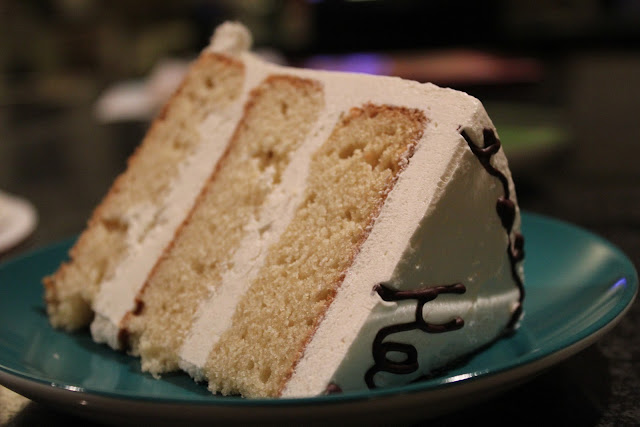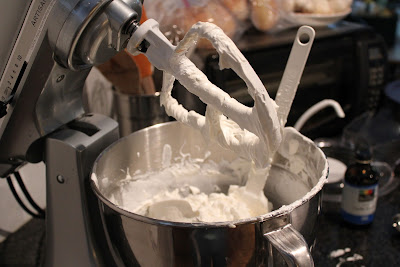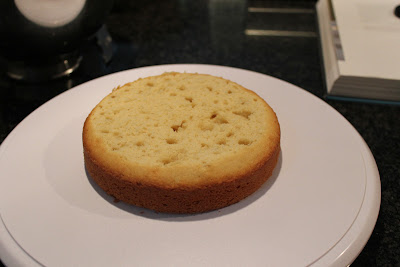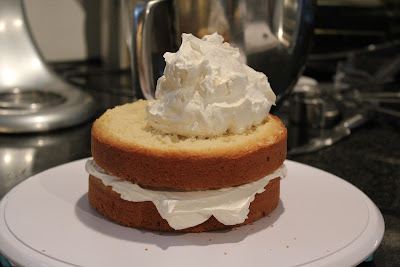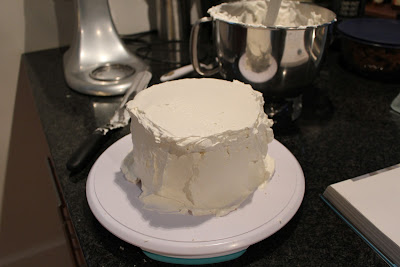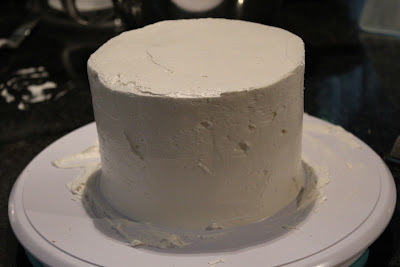Jeff's birthday was a few weeks ago, and I took him to the Capital Grille (in Chestnut Hill) for an extravagant dinner. I left my camera at home, so we could thoroughly enjoy the evening without worrying about whether I had gotten a picture of everything and whether the pictures were any good in the dim lighting. We had an incredible evening that started with wine (Malbec for me; Riesling for him), Wagyu beef carpaccio, and French onion soup; moved onto a porcini-rubbed delmonico and a Kona-crusted dry-aged sirloin complemented by fries, onion strings, sauteed spinach, and asparagus; and finished with a piece of flourless chocolate espresso cake. But that was just Friday.
Not wanting the celebrating to end, over that weekend I made a gorgeous roast and whipped up a birthday cake. You may have noticed from reading this blog that Jeff really appreciates simplicity when it comes to food, so when I asked him what kind of cake he wanted, his answer was no surprise to me: vanilla cake with vanilla frosting. Then he specified that he wanted the Thomas Keller frosting. Simplicity accompanied by, apparently, high standards.
After seeing the adorable cakes Jen has been making with her 6-inch cake pans, I bought some and broke them out to make Jeff's cake, since I was just baking for the two of us. I still haven't found a vanilla/yellow cake recipe I love, so I try different ones all the time. This time it was the one from The Art & Soul of Baking, a book I've come to rely on for so many great recipes.
Vanilla-Vanilla Cake
Ingredients
Cake (adapted from The Art and Soul of Baking)
2 cups cake flour
3/4 teaspoon baking soda
1/4 teaspoon salt
1 1/2 sticks unsalted butter, softened3/4 cup sugar
3 eggs, at room temperature
1 tablespoon vanilla extract
1/3 cup sour cream, at room temperature
Frosting (adapted from Ad Hoc at Home)
1 3/4 cups plus 2 tablespoons granulated sugar
3/4 cups egg whites (from about 6 eggs)
3 1/2 sticks unsalted butter, cut into 1/2-inch pieces, softened
1 tablespoon vanilla extract
Preparation
Preheat oven to 350 degrees. Butter three 6-inch round cake pans and line with parchment circles. Place the cake pans on a sheet pan.
Sift flour, baking soda, and salt into medium bowl, and whisk to combine.
In bowl of stand mixer fitted with paddle attachment, beat butter and sugar on medium speed until very light in color, 4 to 5 minutes. Scrape down bowl.
Beat eggs and vanilla together in small bowl, and with mixer running on medium speed, gradually add egg mixture (about 1 tablespoon at a time), fully incorporating each addition before continuing. Halfway through, turn off mixer and scrape down bowl. Turn mixer back on and continue adding egg mixture. Scrape down bowl again.
With mixer on low speed, add flour mixture and sour cream alternately, starting with one-third of flour mixture, then half of sour cream, and ending with flour mixture.
Scrape down bowl and finish mixing batter with rubber spatula.
Divide batter evenly among the prepared pans (about 250 grams of batter per pan).
Transfer pans to oven, and bake 18 to 20 minutes, rotating halfway through, until toothpick inserted in center comes out clean. (If one cake is ready earlier, remove it from oven and transfer to cooling rack. Continue baking remaining cakes until they are done.) Transfer cakes to cooling rack. Let cool in pans, and then turn out onto cooling rack. (Run a knife or small offset around the cakes to loosen them.) Peel off parchment.
If cakes have risen inconsistently, trim tops so each layer is flat. (Snack on the tops.)
To make the frosting, fill small saucepan with about 1 inch of water, and bring to simmer.
Combine sugar and egg whites in bowl of stand mixer, and set bowl over simmering water. Whisk constantly until sugar has dissolved and mixture is hot to the touch. (I usually rub a little of the mixture between my fingers to check for any graininess. It is hot, though, so use caution if you try this.)
Remove bowl from heat and immediately place on stand mixer fitted with whisk attachment. Whip on high speed until thick and fluffy and bowl and mixture are cool to the touch, 10 to 12 minutes.
Switch to paddle attachment, and with mixer on medium speed, add butter pieces 2 to 3 at a time.
Once butter has all been added, check the consistency. If frosting is too thin, continue beating for a few more minutes to thicken. Turn mixer to low and mix in vanilla.
To assemble the cake, place the bottom layer on a rotating cake stand.
Heap some frosting on top and spread it over the layer and off the sides.
Add the middle layer, and heap frosting on top. Spread the frosting over the layer and off the sides.
Add the top layer, and place another heap of frosting on top. Carefully spread the frosting around the top of the cake and off the sides.
Spread frosting around the outside of the cake, adding more than you need.
Using your offset held flat against the side of the cake, smooth the frosting around the cake, scooping off any excess. (If you want the frosting to be super smooth, you can run your offset under hot water, dry it off, and smooth the sides of the cake with it. I didn't do that this time.)
To finish the top of the cake, using an offset, pull the frosting at the edge of the cake toward the center, working your way around the cake and scraping the excess frosting off the offset between each pull.
Transfer the cake to an 8-inch cardboard cake circle.
Scoop leftover frosting into a pastry bag fitted with a star tip, and pipe a border around the bottom of the cake.
 |
| It's always a good idea to practice on the counter first. |
I find it easiest to pipe a border by bringing the cake right to the edge of the counter, getting level with it, and turning the cake as I go.
 |
| Gunner appreciated that I put the cake right at the edge of the counter. |
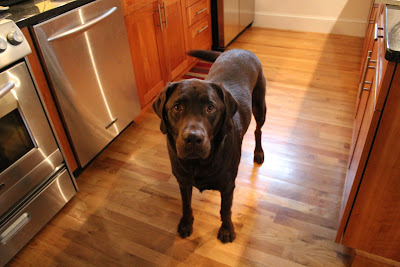 |
| "What do you mean I can't have any cake?" |
You'll likely have extra frosting, but I always prefer to have more rather than not enough.
Decorate and write on the cake if you like. I made a paper cone, filled it with bittersweet chocolate, melted the chocolate, and used that to decorate the cake.
I liked the flavor of the cake, but I found it a little bit dry, and I wished I had brushed it with a flavored syrup before assembling the cake. I also think if I had cut each of the three layers in half and made a six-layer cake with frosting between each layer, it would have been a little better. I like frosting, what can I say?
And this frosting is amazing. It's very fluffy, not sickeningly sweet, and has a pleasant vanilla flavor. It's a little more work than your typical frosting, but it's worth it.
Do you have a favorite yellow cake recipe I should try?

